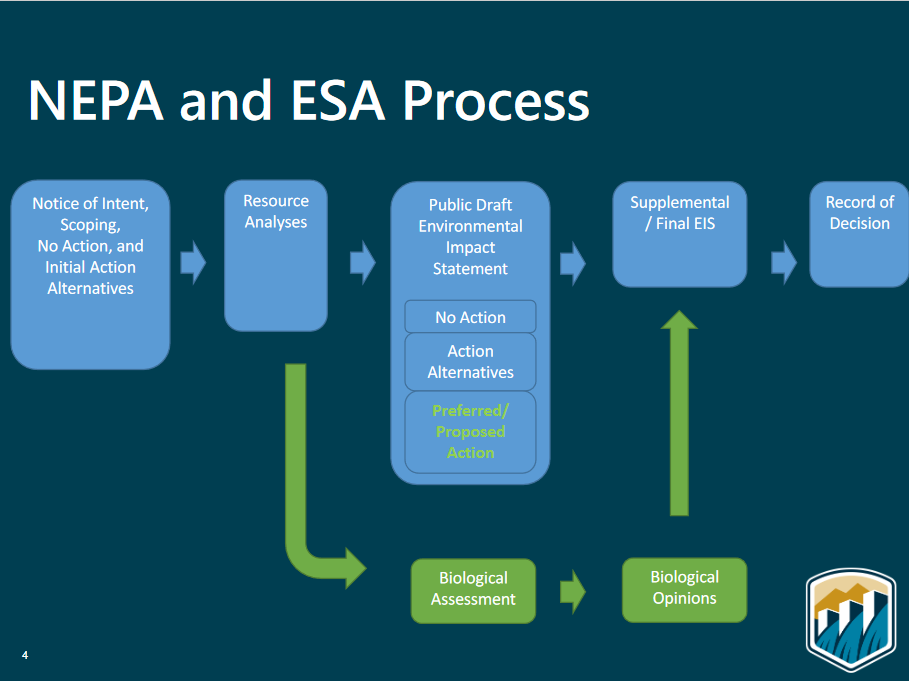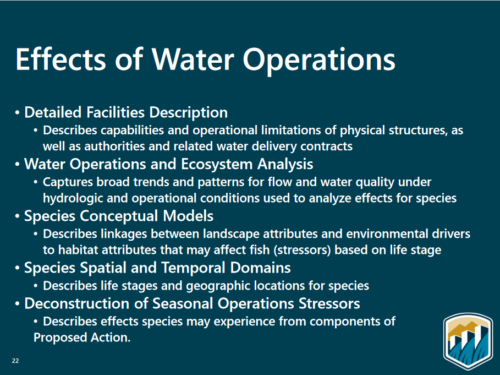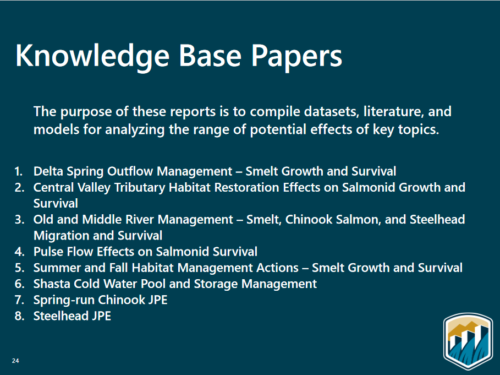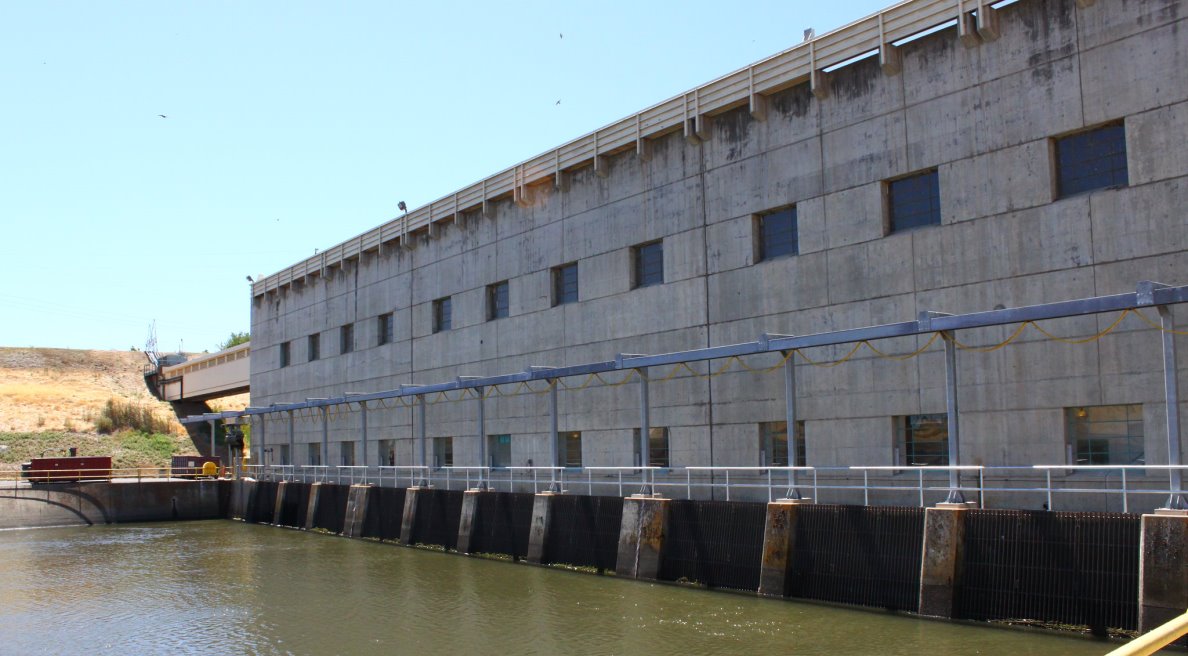For the Central Valley Project and the State Water Project to comply with the federal Endangered Species Act, the Bureau of Reclamation and the Department of Water Resources consult with the federal fish agencies, the National Marine Fisheries Service and the U.S. Fish & Wildlife Service, on the operation of the water projects. The federal fish agencies each then issue a biological opinion that includes specific actions intended to enable the long-term operations of the water projects without jeopardizing listed species. For the State Water Project to comply with the California Endangered Species Act, the Department of Fish and Wildlife issues an Incidental Take Permit to the Department of Water Resources through a similar process.
The last time the biological opinions were issued was in 2019, during the Trump Administration. Litigation ensued. However, in September of 2021, Reclamation requested to reinitiate consultation due to requested due to anticipated modifications that may cause effects to ESA-listed species or designated critical habitat not analyzed in the 2019 FWS and NMFS Biological Opinions. These modifications would address the review of the 2019 biological opinions required by Executive Order 13990 Protecting Public Health and the Environment and Restoring Science to Tackle the Climate Crisis, and voluntarily reconcile the Central Valley Project operating criteria with the requirements of the State Water Project under the California Endangered Species Act (or CESA).
On June 14, the Bureau of Reclamation held its first quarterly meeting to provide an update on the reconsultation of the long-term operations for the Central Valley Project and State Water Project as required by the WIIN Act.
The diagram shows the NEPA and ESA reconsultation process. The process is in the early stages; scoping has been completed, and they are currently developing the initial action alternatives.
 The Bureau of Reclamation published the Notice of Intent (or NOI) in the Federal Register on February 28, 2022. Reclamation hosted six virtual public scoping meetings between March 8 and 17, 2022. The comment period closed on March 30, 2022.
The Bureau of Reclamation published the Notice of Intent (or NOI) in the Federal Register on February 28, 2022. Reclamation hosted six virtual public scoping meetings between March 8 and 17, 2022. The comment period closed on March 30, 2022.
A scoping report contains all the comments gathered during the public comment period, including those comments given at the meetings and submitted through mail or emails. Many groups provided comments, including several Tribes, federal and state agencies, public water management agencies, farmers and producers, commercial and sport fishermen organizations, power utilities, conservation NGOs, local citizens, and commercial water developers.
Examples of comments received during the scoping process
Cindy Meyer, Natural Resources Special Assistant with the Bureau of Reclamation, reviewed some of the comments received during scoping, noting that it is not a complete list. All comments received are included in the scoping report.
Project Purpose, Scope, and Analysis Related Comments
- The Purpose and Need must clarify that meeting water supply contracts are a secondary project purpose after meeting compliance with ESA.
- The purpose, need, and alternatives should be tied directly to CVP statutory requirements and contractual obligations.
- Since it influences the range of alternatives, the scope of the purpose and need should state that multi-use water projects are primarily water supply projects paid for by local water agencies with long-term water supply contracts with Reclamation and DWR.
- The Purpose and Need should comply with CVPIA and reduce reliance on the Delta for water exports as required by the Delta Reform Act.
Endangered Species Act-related comments
- Reclamation should not consider any of the actions challenged in the 2019 Biological Opinions for inclusion in any potential proposed actions or alternative analyses in this EIS because those issues are being litigated and should not be carried forward into this analysis.
- Reclamation has violated D-1641 water quality objectives that were part of the proposed action in 2021 and 2022 in a manner that causes additional impacts to listed species that were not considered in the 2019 Biological Opinions or ROD.
Biological Resources Related Comments
- The EIS should consider Shasta strategies for cold-water pool management to protect winter-run Chinook salmon while minimizing water supply losses.
- Collaborate with California to alter existing Chinook salmon and steelhead hatchery practices to benefit wild populations of these species.
- The EIS should analyze the effects that temperature management measures to benefit salmonids would have on migratory birds and wetland habitat.
Agriculture Related Comments
- Drinking water must be prioritized over agricultural exports.
- Reclamation should reduce diversion and export quantities by not providing water for high water-demand permanent crops
- Consider the importance of the Central Valley for agriculture production during the analysis.
Groundwater/Water Quality-Related Comments
- Include potential expanded on-farm recharge in strategic locations on the eastern edge of California’s Central Valley, as well as proposed large-scale groundwater banking facilities.
- Fix issues relating to land subsidence along the Friant-Kern Canal and intensive local development of groundwater-managed aquifer replenishment projects in the San Joaquin River and Tulare Lake Basin, all along the Eastside of the Central Valley.
- Recognize impacts on water quality, including dry-year impacts and potential impacts on irrigation, crop yields, and salt-trapping in the Delta.
Cultural and Tribal Related Comments
- The CVP must consider the sovereignty of the Hoopa, Yurok, Karuk, and Wiyot tribes because actions that deplete water from rivers in northern California infringe on the tribes’ sovereignty by affecting healthy salmon runs and the availability of drinking water.
- Carryover storage in reservoirs should be saved for tribal trust responsibility.
- Salmon as a cultural resource should be analyzed in the draft EIS.
Water Storage and Conveyance Related Comments
- The EIS should analyze the potential integration of the proposed Sites Reservoir Project with continued long-term CVP operations.
- Reclamation should analyze and mitigate for the negative impacts of reduced carryover storage for refuge water supply contractors in San Luis Reservoir.
- No alternative should consider releases from New Melones to meet Bay-Delta demands if they can be met by other reservoirs because New Melones is a priority for local water use.
Social and Economic Related Comments
- The EIS should analyze the effects of reduced allocations to the district on poverty rates.
- Comply with Executive Order 12898, “Federal Actions to Address Environmental Justice in Minority Populations and Low-Income Populations” (February 16, 1994).
- In the Draft EIS, include information describing what was done to inform minority and low-income populations about the project and the potential impacts it will have on their communities.
Climate Change and Drought Related Comments
- Reclamation should incorporate the potential for reduced streamflow conditions in the Delta and its watershed under climate change because a warmer climate will bring changes.
- Reclamation should develop a plan to meet minimum water quality objectives during droughts rather than relying on Temporary Urgency Change Petitions.
- Model and analyze effects during multi-year droughts such as 2016-2021.
Additionally, comments were submitted on other topics, including recreation, regulatory, scoping process, water rights and water contracts, and water conservation. To read all the comments received, see the scoping report.
Next, the public draft EIS will be developed considering the public scoping comments received.
Initial action alternatives
NEPA requires the Bureau of Reclamation to examine a reasonable range of alternatives. The initial alternatives are used to analyze a broad range of options before identifying the reasonable range of alternatives that will be eventually analyzed in the draft environmental impact statement. The comments received during scoping will be considered during the development of the initial alternatives.
Those initial alternatives will be discussed at the next quarterly update scheduled for September 13. The goal is to complete the proposed action and the alternatives for the draft EIS by December of 2022.
 To develop initial alternatives, the effects of water operations need to be understood. The slide lists some of the information they have used to build that understanding. Using that information, they will determine the stressors likely to adversely affect species and identify where conservation measures may be needed.
To develop initial alternatives, the effects of water operations need to be understood. The slide lists some of the information they have used to build that understanding. Using that information, they will determine the stressors likely to adversely affect species and identify where conservation measures may be needed.
Reclamation is working with other agencies to develop knowledge-based papers on the more complex and controversial topics. These papers include compiled datasets, literature, and models for analyzing the range of potential effects of key topics. They are meeting monthly with public water agencies and NGOs to discuss the knowledge base papers and the development of the alternatives. (If you would like to attend these meetings, reach out to EMAIL, and they will add you to the list.)
 “We welcome additive information for inclusion in these knowledge base papers,” said Ms. Meyers. “So if you have some great research that’s been sitting on your desk for five years that you haven’t published yet, but you feel would be very useful to us, please send that along with a brief explanation of why that’s pertinent and useful. Or, if you have peer-reviewed journal articles or data, we welcome those as well. We want to make sure that we are using the best available science as we move forward. And we welcome your contributions.”
“We welcome additive information for inclusion in these knowledge base papers,” said Ms. Meyers. “So if you have some great research that’s been sitting on your desk for five years that you haven’t published yet, but you feel would be very useful to us, please send that along with a brief explanation of why that’s pertinent and useful. Or, if you have peer-reviewed journal articles or data, we welcome those as well. We want to make sure that we are using the best available science as we move forward. And we welcome your contributions.”
Timeline:
- September 2022 meeting: Initial alternatives
- December 2022: Public draft alternatives
- March 2023: Draft EIS and the biological assessment.
- DELTA INDEPENDENT SCIENCE BOARD: How the State Water Project and Central Valley Project comply with the endangered species acts, post at Maven’s Notebook
- 2021 Consultation on the Coordinated Long-Term Operation of the CVP and SWP, webpage from the Bureau of Reclamation
- Central Valley Project and State Water Project Biological Opinion Published, webpage from NOAA Fisheries
- Central Valley Project and California State Water Project Consultation, webpage from the US FWS



